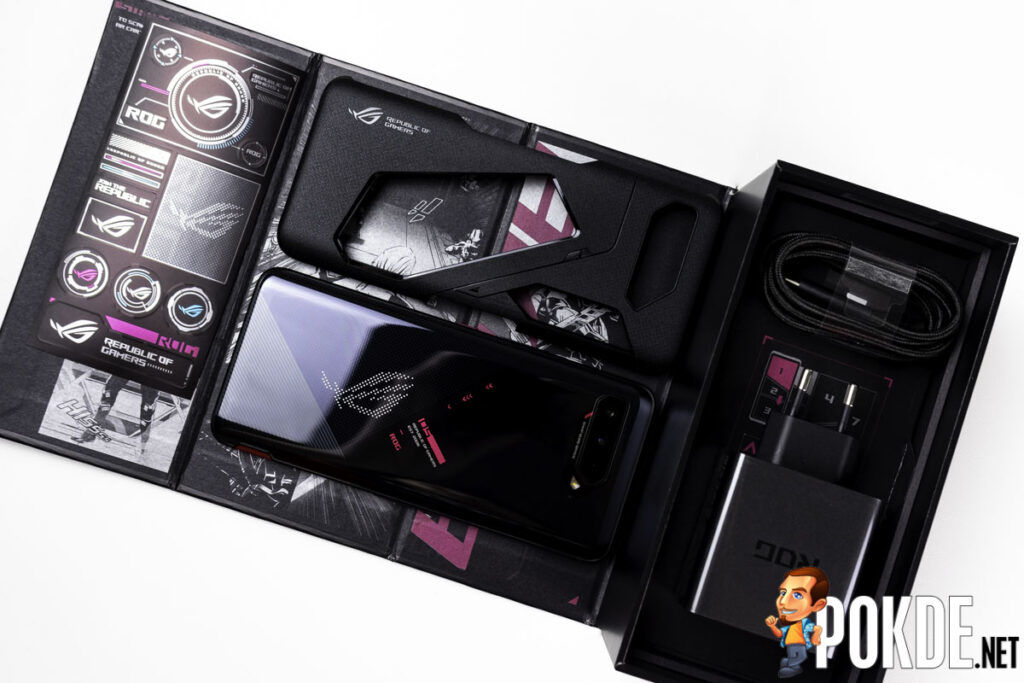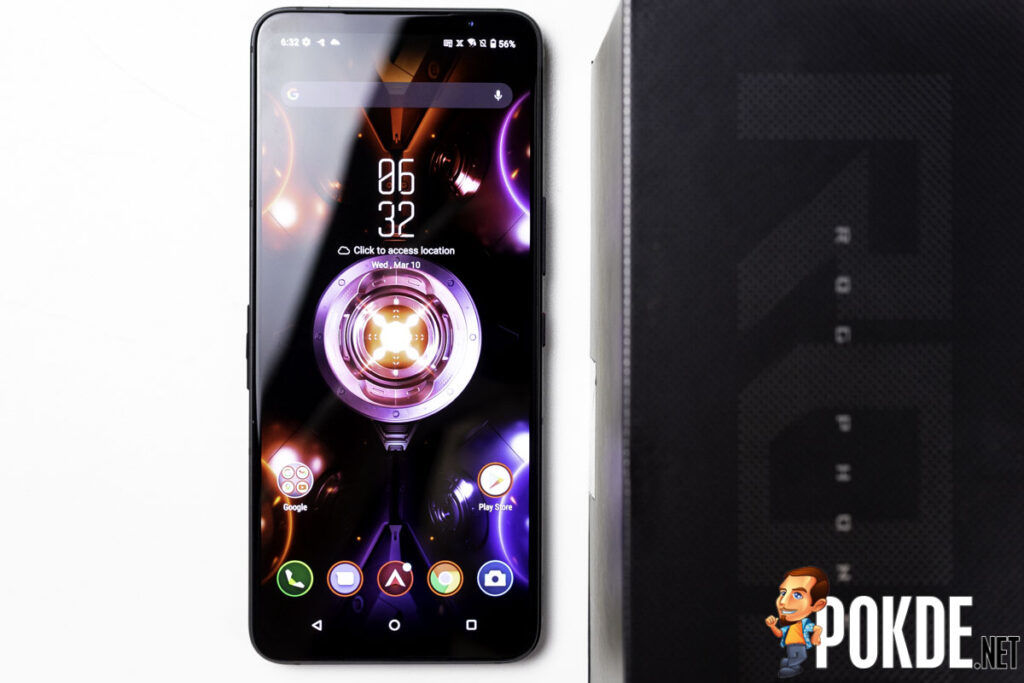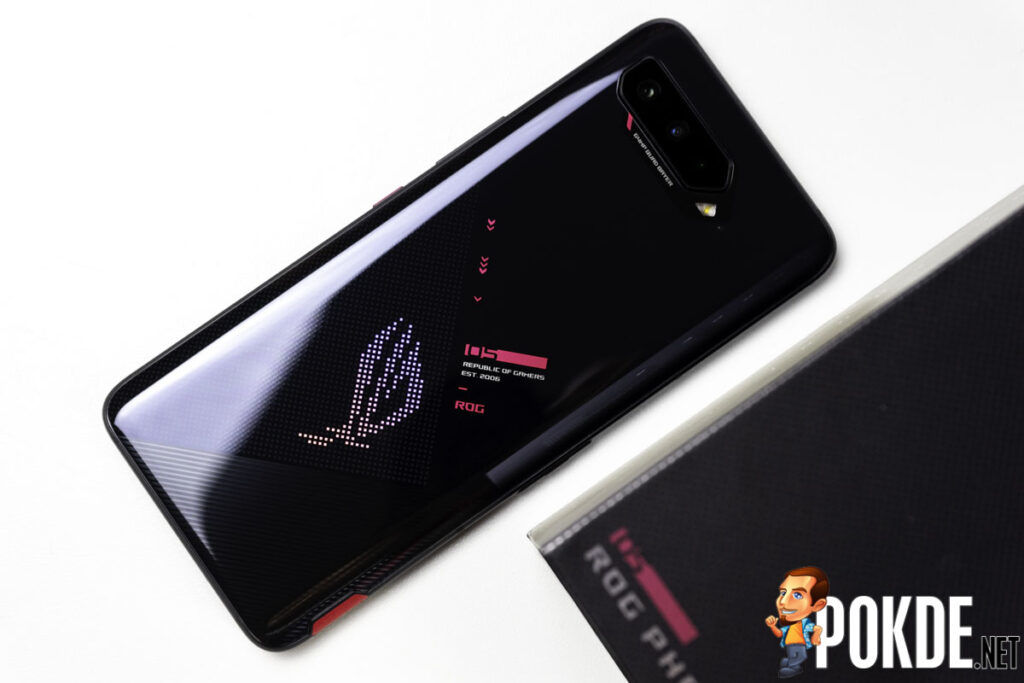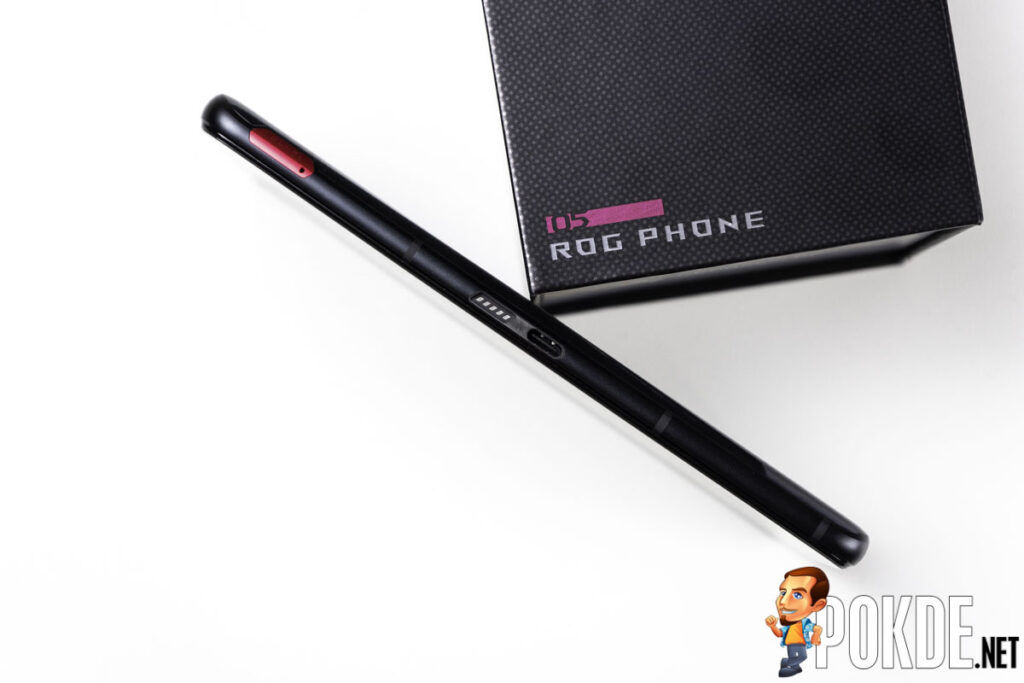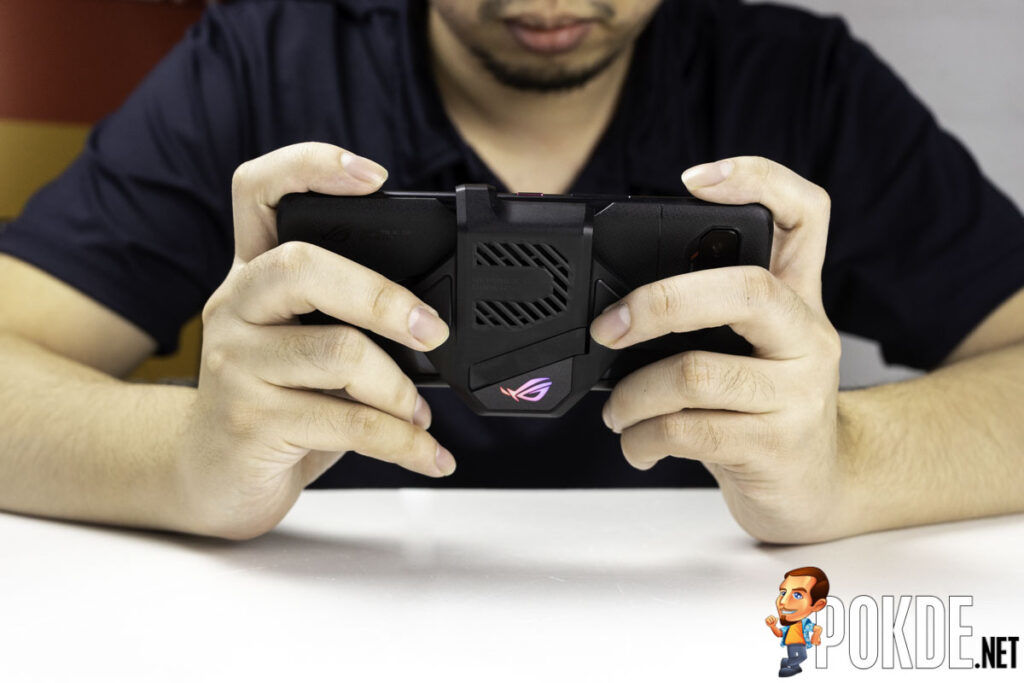ASUS ROG Phone 5 Review — sexier than ever!
-
Appearance - 8.9/10
8.9/10
-
Efficiency - 7.5/10
7.5/10
-
Features - 9/10
9/10
-
Materials - 8.6/10
8.6/10
-
Performance - 8.8/10
8.8/10
-
Portability - 7.8/10
7.8/10
-
User Experience - 8.5/10
8.5/10
-
Value - 8.2/10
8.2/10
Summary
ASUS refines the ROG Phone formula further with the ROG Phone 5, even if it means having to make a few contentious decisions.
Overall
8.4/10Pros
+ New design looks absolutely gorgeous!
+ AeroActive Cooler 5 delivers much better sustained performance
+ 65W fast charging is excellent for quick battery top ups
+ New internal layout puts the hottest parts away from your hands
+ 144Hz display is a joy to use with great fluidity and excellent colors
+ Mind-blowingly good sound from the built-in stereo speakers
+ Improved RGB lighting is nice to have
+ Good camera performance in the right situation
Cons
– Mediocre battery life despite huge 6000mAh battery
– Snapdragon 888 can run quite hot
– Pogo pins on the AeroActive Cooler 5 can scratch the frame
– Camera shutter lag gets annoying for point-and-shoot usage
– Macro camera needs autofocus
– No backward compatibility with a large chunk of accessories that made the ROG Phone series unique
The ASUS ROG Phone series has been a rather prolific one. Starting with the ASUS ROG Phone, the series pretty much redefined the whole gaming smartphone scene by packing AirTriggers to provide a massive advantage in mobile FPS titles. Further refinements improved the ROG Phone lineup as the years went by, and now we are looking at the fourth generation ROG Phone, the ROG Phone 5. Does it have what it takes to not only live up to its predecessors, but also succeed in where they didn’t? Well, we will see.
Unboxing
The packaging of the ROG Phone 5 has been simplified for this generation, and you don’t get the hexagonal box unless you shell out extra for the ROG Phone 5 Pro and ROG Phone 5 Ultimate. It is still quite unique, with the box unfurling to reveal its innards, and it also has the advantage of not risking the device falling out of the box by accident when unboxing the device, unlike the ROG Phone 3’s box.
The contents are pretty much everything you would expect to come with an ROG Phone, with the sole exception being the AeroActive Cooler 5. ASUS has decided to omit it from the box of the base ROG Phone 5, instead only bundling it with the ROG Phone 5 Pro and Ultimate. But you still get a charger, and a 65W USB-PD one at that, so I guess it is almost justified. And look at those stickers! You can also watch the unboxing video below to get a feel of the ROG Phone 5’s unboxing experience:
Appearance
The front of the ROG Phone 5 is dominated by the display, more so than its predecessors thanks to narrower bezels. Instead of the mesh that offered a more distinct visual indicator of where the stereo speakers are located, you now get a tiny inconspicuous slit between the frame and the glass.
With that said, the top and bottom bezels do make the ROG Phone 5 look somewhat dated compared to recent flagships, but the selfie camera’s position is justified by ASUS wanting to make it more practical for mobile gamers to stream directly from the ROG Phone 5 itself.
Meanwhile the back has been revamped with a more streamlined design than their previous generations, losing the cooling vents and accents that defined the previous gen ROG Phones, while gaining the Dot Matrix RGB that’s reminiscent of the wildly popular ROG Zephyrus G14’s AniMe Matrix panel.
The diagonal lines along the bottom edge further accentuates the whole design, making for a sleeker look overall along with the darker finish than its predecessors’. Last but not least, a sprinkle of Electro Punk pink to spice it up. The camera bump seems to be carried over directly from the ROG Phone 3, and the hardware does point towards that. More on that later.
Another “new” feature in the ROG Phone 5 is the return of the headphone jack, which disappeared in the ROG Phone 3 to the chagrin of many. The ROG Phone 5 still has the offset USB-C port on the bottom to allow users to charge it while you are gaming on it, despite the fact that it has another USB-C port on the side. You can see a little microphone hole drilled into the antenna line here, and it is one of the four microphones on the ROG Phone 5, with the other ones placed on the top edge, rear and also on the right edge.
The ROG Phone 5 also revamped the side port on the ROG Phone 5. Replacing the secondary port that flanks the USB-C port with pogo pins. This is a pretty interesting decision as well, and we will definitely have to talk more about it later.
Overall the ROG Phone 5 offers quite a few distinct visual changes coming from previous generations of the ROG Phone family. The all new Dot Matrix RGB is refreshing and is more inline with the design language used in recent ROG products. And it looks awesome, which is the most important part of all.
ROG Phone 5 Specifications
| CPU | Snapdragon 888, 5nm FinFET 1 x Cortex-X1 @ 2.84 GHz + 3 x Cortex-A78 @ 2.42 GHz + 4 x Cortex-A55 @ 1.80 GHz |
| GPU | Adreno 660 @ 840MHz |
| Memory | 16GB LPDDR5-3200 |
| Storage | 256GB UFS 3.1, non-expandable |
| Display | 6.78″ FHD+ (2448 x 1080) AMOLED display, 144Hz refresh rate, 1ms response time, 300Hz touch response Delta E < 1, HDR10+, 1200 nits peak brightness, 111% DCI-P3 gamut, Corning Gorilla Glass Victus |
| Camera | 64MP f/1.8, Sony IMX686 13MP f/2.4 ultra-wide angle, 125° FoV 5MP f/2.0 macro camera, fixed-focus (4cm) AI Camera, Auto HDR, Auto Night Mode, Night Mode, Motion Tracking, Portrait, Pro Video, Up to 720p480 / 4K120 slow-mo, Up to 4K60 / 8K30 video |
| Selfie camera | 24MP f/2.0 selfie camera 1080p60 video recording, Portrait mode, Auto HDR |
| Connectivity | 5G Band n41/77/78/79, n1, n3, n5, n7, n8, n12, n20, n25, n28, n38, n40 LTE Band 1/ 2/ 3/ 4/ 5/ 7/ 8/ 18/ 19/ 20/ 26/ 28 WiFi 802.11 a/b/g/n/ac/ax, WiFi 6E Bluetooth 5.2 NFC Dual-band GPS USB 3.1 Gen2 (10Gbps), DisplayPort 1.4 (side-port) |
| Battery | 6000mAh 65W HyperCharge, 65W charger in the box 65W QuickCharge 5.0, USB-PD 3.0, Direct Charge |
| Dimensions | 173 x 77 x 9.9 mm |
| Weight | 239g |
| Ingress protection | No |
Performance
As this is the second Snapdragon 888 smartphone we have tested to date, we have a pretty good idea of what to expect. Of course, ASUS adds to the equation with X Mode and X Mode+, the latter which is only accessible when the AeroActive Cooler 5 is attached. We will be comparing the ROG Phone 5 against the other smartphones we have reviewed with the ROG Phone 5 running at default settings, and without the fan.
Antutu sees the ROG Phone 5 best all the other smartphones we have tested, although it barely ekes out a lead over Xiaomi Mi 11. Not too surprisingly though as they both feature the same Snapdragon 888 chipset, unlike previous generations of the ROG Phone which had the advantage of an overclocked chipset as compared to its contemporary peers.
The ROG Phone 5’s CPU performance quite literally trades punches with the Xiaomi Mi 11. The Mi 11 takes the lead in single-core performance, while the ROG Phone 5 takes over in multi-core performance.
We see a somewhat similar scenario in 3DMark. We did not get to test the ROG Phone 3 in the updated 3DMark Unlimited benchmarks, but you can expect it to deliver a nice leap forward here, given the gap between the ROG Phone 5 and the Snapdragon 865-class devices we have recently tested.
PCMark performance is quite abysmal, in fact underperforming even when compared against the ROG Phone 3. We aren’t exactly sure why, but PCMark scores have always been quite a mess. Usually PCMark prefers devices with more memory, but somehow the ROG Phone 5 doesn’t do too well here. Probably because ASUS tuned it towards excelling at gaming and not productivity?
X Mode & X Mode+
ASUS’ implementation of X Mode and X Mode+ doesn’t guarantee a performance increase, but when it does, the difference can be rather huge. It seems that it benefits longer benchmarks the most, which is what you would expect, considering that X Mode+ is only enabled when the fan is attached. Short benchmarks like Wild Life Unlimited and Geekbench sees virtually no benefit at all from enabling the higher performance profiles. The biggest gains are seen in PCMark, allowing the ROG Phone 5 to come from behind to outperform every other flagship we have tested previously.
Battery life
Battery life is good enough at 60Hz, but as we have seen, the Snapdragon 888 does result in the ROG Phone 5 looking a bit lackluster in this benchmark, especially when pitted against its predecessor with a similarly-sized battery. It does outlast the competition by having a significantly larger battery than pretty much any phone out there, so while efficiency isn’t in the ROG Phone 5’s favor, battery life is still good enough in the PCMark benchmark.
However it doesn’t exactly impress when I used it as my daily driver. Battery life in my normal usage with the Dynamic profile and the refresh rate set to Auto is pretty mediocre, with only five hours and 23 minutes away from the plug. Thankfully the recharging process is really quick, with the included 65W charger bringing the battery up from 10% to 68% in just 30 minutes.
Thermals
With the ROG Phone 5 I think a lot of you guys would also be interested in the thermal performance. In the Wild Life Stress Test, which runs 20 loops of the Wild Life benchmark, sees that the ROG Phone 5 gradually loses quite a bit of performance over time. This is actually expected behavior, as a mobile chipset is supposed to throttle to stay within its appropriate temperature limits.
Enabling X Mode allows for higher scores in the first few runs, before dropping sharply due to the more aggressive boost in the initial runs. If you plan on enjoying consistent performance, using the Dynamic profile might be the better choice versus X Mode that seems to target more bursty performance.
The situation changes once I attached the fan though, as the results with the X Mode+ profile are absolutely stellar, with the additional cooling from the AeroActive Cooler 5 allowing the ROG Phone 5 to deliver consistent scores across the 20 runs. It seems that the X Mode+ profile also doesn’t push for peak scores as much the X Mode profile in the initial runs, which somewhat explains the former’s weaker scores we saw in short benchmark runs versus those obtained with X Mode enabled.
While games like COD Mobile and PUBG Mobile aren’t taxing enough to cause the ROG Phone 5 to break a sweat, the story is quite different if you are pushing Genshin Impact at maximum graphics and at 60FPS. The center of the screen, which is right above (behind?) the chipset goes up to a toasty 45°C with the fan attached after about 10 minutes of gameplay. ASUS reports internal temperatures of up to 43°C. Unplugging the fan saw it creep up to around 48°C. There wasn’t any noticeable throttling though, so that’s nice to note.
I was testing in a 25°C air-conditioned environment, so the fan also helps move cold air around the back of the device a bit, which makes for a more comfortable holding experience. Not as much as the previous generations, but it does seem like this generation’s AeroActive Cooler 5 is quite a bit more effective at dropping system temperatures, most probably due to the internal layout of the ROG Phone 5. The new arrangement that sees the hot Snapdragon 888 placed along the middle of the device also means that you won’t be feeling the heat as much on the sides of the ROG Phone 5, allowing to game more comfortably.
User Experience
Display and Audio
The main draw of the first-gen gaming phone is a high refresh rate display, and the ROG Phone 5 comes with a 144Hz AMOLED display. I won’t get into how you can’t really enjoy that in most of the popular games today, but the ROG Phone 5 does offer a really smooth experience in pretty much everything you do. And it is also worth noting that the color shifting when switching between refresh rates isn’t as noticeable on the ROG Phone 5, as it was on previous ROG Phones.
However a high refresh rate doesn’t exactly stand out as much anymore unlike a few years back when high refresh rate displays were only available exclusively in gaming phones. Not to mention non-gaming flagships are now boasting of higher resolutions and narrower bezels than the ROG Phone 5, while also touting competitive 120Hz refresh rates which makes the display here seem even less exciting. It is still a great display for viewing content, but I want to see more from the Republic of Gamers than the same 144Hz refresh rate two generations in a row.
Moving on, let’s get to the good news. The ROG Phone 5 has a really impressive pair of stereo speakers hidden behind those tiny slits. It even has a little bit of bass, which was absolutely not expected. I do find it to offer just a tad too little bass, but I easily remedied it by bumping up the bass slider in AudioWizard. The fact that it could actually pump out more bass was also an impressive fact in itself. I guess I understand why DxOMark was gushing about the audio capabilities of the ROG Phone 5.
Software
ASUS’ custom UI has always touted a very aggressive theme, and the ROG Phone 5 is no different. Aside from the color theme and the Armoury Crate hub, much of it is pretty similar to Zen UI of yore. There are a lot of stock elements still left intact, like the way the notifications are presented as well as the overall layout of the UI. With that said, ASUS has had a rather clouded past when it comes to software updates, so I am not sure if we will see more of the same. The ROG Phone 3 has yet to receive an official update to Android 11, with ASUS rolling out the beta update just recently. Hopefully we will not see the same for the ROG Phone 5.
Let’s now check out Armoury Crate. ASUS baked in a lot of settings to play around with in the same Console tab. You can switch between the different power profiles, or even adjust the thermal limits to extract the most performance out of it. In our testing, X Mode+ was the most effective, so the Advanced performance profile was mostly moot, at least from a performance benchmarking perspective.
The Advanced mode offers more options than X Mode+ when it comes to the network settings, letting you toggle stuff like automatic regulation of the carrier aggregation and 5G capabilities. You can even adjust the sensitivity of the touch screen, lower the touch sampling and more. It essentially offers all the customizable performance and power saving features that’s available in the ROG Phone 5.
And now onto the coolest part of the ROG Phone 5, the RGB LEDs. While the ROG Phone 5 doesn’t have the ROG Vision, the Dot Matrix RGB used for the ROG emblem is still a joy to customize. With two LEDs, the iconic ROG logo can now more smoothly transition through the RGB range, in addition to supporting other lighting modes like Mixed Lights that allow you to mix two different colors for extra personalization.
While it was as simple as adding an LED, ASUS definitely offers a lot more freedom with the ROG Phone 5 to make it truly yours, as compared to its predecessors. It is also worth noting that the AeroActive Cooler 5 also sports a similar two LED setup, so the fancy lighting setups can also be carried over to cooler.
There’s also a list of titles that support the features on the ROG Phone 5 in the Featured tab, like the 144Hz and 120Hz refresh rates, Kunai 3 GamePad and Air Triggers. That’s an easy way to identify which games to try out, although there are surprisingly few popular titles that have updated to support the feature set offered by today’s high-end gaming phones like the ROG Phone 5.
Another key aspect of the ROG Phone 5’s gaming experience is GameGenie. Interestingly enough, the ability to stream directly from GameGenie has been quietly removed, and in its place you get a Record button. Here’s is where you get to assign the AirTriggers, AeroActive Cooler 5’s buttons and change a number of settings, all via a swipe from the left edge of the screen in landscape mode.
Gaming
Since we are on gaming, we definitely have to talk about the ROG Phone 5’s AirTriggers. ASUS claims to have added extra sensors to improve the sensitivity and precision. However I found even the original’s ROG Phone AirTriggers to be good enough for my use, so I am not really feeling the advantage here.
It can also be split into two customizable partitions, so you can essentially have a total of four triggers in games, although there’s no physical indicator for the partition so it will take some getting used to. If you prefer you can also use swiping or sliding gestures, but I didn’t exactly find them suitable for FPS gaming. You still can’t overlap the swiping gestures with taps, which is a slight bummer.
The ROG Phone 5’s triggers can also be augmented by the AeroActive Cooler 5’s triggers. While they do not come in the box, it is still a pretty affordable way to add two more buttons to the ROG Phone 5’s back. The triggers are sensitive with tactile actuations, so you will definitely know when you have triggered something. They work in the same way as the AirTriggers do, and you can assign the triggers to a virtual tap anywhere on the screen with GameGenie.
While ASUS improved the AeroActive Cooler 5 by adding more buttons, the change to the pogo pins is quite a bit more contentious. On top of ending backward compatibility with stuff like the ROG Mobile Desktop Dock and TwinView Dock, the AeroActive Cooler 5 now latches on like a clip, and is not nearly as secure as the mounting mechanism of the previous AeroActive Coolers.
Also, it runs the chance of scratching the frame if you aren’t careful. In my four weeks of use thus far, it has left small scratches the frame near the pogo pins as I had to slide it around a bit to get the pins to align into the slot, and that wouldn’t have happened if ASUS had allowed the AeroActive Cooler 5 to expand and clip onto the ROG Phone 5 like their previous AeroActive Coolers.
Camera
The camera appears to be carried over directly from the ROG Phone 3, which means a 64MP primary camera mated up with a 13MP ultra-wide camera and a 5MP macro camera. The lack of autofocus in the macro camera was enough to make me dislike it right away, but let’s give it a whirl anyway.
The camera UI is pretty familiar from previous ZenFone and ROG Phones. It is quite unfortunate though as while the layout is pretty good, there’s a tangible lag between me tapping the shutter button and when the ROG Phone 5 actually snaps the photo, especially when the UI decides that HDR is necessary for a good shot. That has resulted in plenty of shots turning out blurry, when I had no issue taking them with my other devices.
With that said, the HDR does result in some really nice shots, in the right situations. I have noted it since the ASUS ZenFone 5z, that ASUS does some of the best HDR effects out there. However it can also cause some shots to look over-processed, so your mileage may vary. If you have steady hands, the ROG Phone 5 can take some great photos, but ASUS should definitely fix the slight delay. And also add autofocus to the macro camera too, as it is quite good, but the manual focusing by moving the phone forward and backwards is just too unacceptable in a flagship. You can view the full-sized photos here.
Conclusion
While building upon the best gaming phone can be a tall task, it seems that the guys at ROG still have quite a few cards up their sleeves. For RM3799, the ROG Phone 5 is a very strong option for ardent mobile gamers. It now boasts faster charging, better audio, an improved display, the return of the headphone jack and also a much more useful AeroActive Cooler 5.
I still don’t exactly like the fact that the AeroActive Cooler 5 is not included with the ROG Phone 5 though, especially when the ROG Phone 5 isn’t compatible with any of the previous AeroActive Coolers. Speaking of which, I think most ROG Phone 5 owners will end up buying one. The cooler seems to do a much better job of actually cooling the device instead of just blowing air towards your hands this time around.
There are much more noticeable differences in thermals, probably because the Snapdragon 888 just gets much hotter than its predecessors, and actually needs active cooling to fully stretch its legs. The new triggers on the AeroActive Cooler 5 also add value, making it almost a must-have if you want the best gaming experience possible on your ROG Phone 5.
But it’s not all great with the AeroActive Cooler 5. While I can foresee the change to pogo pins might be for the better, ASUS could definitely improve the ease of attaching it by either adding magnets to the back of the phone to make sure that you can always align it perfectly without having to slide it around on the frame, or just go back to the previous AeroActive Coolers’ clip design.
And while I have never used most of the ROG Phones’ extensive accessories lineup like the Mobile Desktop Dock and TwinView Dock, I do believe some might find it extremely annoying that they can no longer use them with the ROG Phone 5.
So yeah, if you are still reading, you will notice that most of my complaints about the ROG Phone 5 is its support for accessories. The ROG Phone 5 itself is one excellent gaming phone, but as with the ROG Phone 3’s missing headphone jack, it seems that ASUS just has to mess something up this generation, and that would be the new pogo pins.

Our thanks to ASUS Malaysia for sending us the ROG Phone 5 for review. Get your ROG Phone 5 here.








